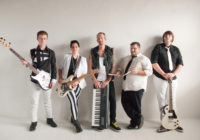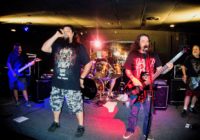Friday November 9, the hallowed halls of finer Dayton based education held a symposium on a subject of great interest, historical value, global impact and social significance. Four renowned highly educated intellectual professionals came to discuss a subject many of the student body loved and many around the word live as a lifestyle. Dr. Esther Clinton and Dr. Jeremy Wallach of Bowling Green State University, Dr. Deena Weinstein of Depaul University and Dr. Mark LeVine of California-Irvine all brought their esteemed, world traveled knowledge to enlighten us on the finer spoken points and high society standards of the world’s greatest musical contribution… Heavy Metal. Sponsored by The UD Arts Series, Office of the Dean of the College of Arts and Sciences, Departments of Communications, English, History, Music, Sociology, Anthropology and Social Work. Also the Roesch Library, Ryan C. Harris Learning Teaching Center, Alumni Chair of Humanities and Social Justice LLC and Service Club.
Each gave a different and unique presentation to a packed room in the Sears Recital Hall at the Jesse Phillips Humanities Center on the effects, sounds, culture, emotional impact, history and understanding of the genre as a whole and fascinating insight into its distinctive subgenres.
Dr. Clinton a professor of popular culture and teacher/writer of Folklore, Popular/Material Culture began her lecture, “Who has Access?- Comparing the Moral Panic About Gothic Literature in the Late 18th Century and Heavy Metal Music in the 1980’s.” She made several comparisons to the themes of gothic literature and Metal such as the often used dark and stormy night verbiage used in novels which was present in metals earliest form, the first Black Sabbath record with its eerie downpour and looming church bell. The music sounds dark, using minor keys, reverb and the dreaded tritone. The theme of human/personal/supernatural evil widely used by Sabbath, historically becoming one of the genre’s biggest lyrical go to subjects was often symbolized by the dark characters within the gothic works. Moral panics were brought on by both forms of expressionism. The PMRC gave us the 15 worst song list questioning their lyrical content on the young minds of the time. Gothic literature gave woman a great sense of empowerment as they could control or influence men using their powers of persuasion. They were given strong roles, standing up to men and allowed to enjoy the more physical side of life in these stories which helped the female literacy rate go up. In 1870 a law was passed which gave women access to these ‘fun’ books which were passed around and shared much like the underground tape trading scene of the early 80’s. So if you lived back in the day and were luckily enough to get a presumably well- read, well-worn ‘early’ copy of Frankenstein, Dracula or the era’s first novel The Castle of Otranto it would be similar to a friend giving you a re-re-re-re-copied underwater sounding cassette of Metallica’s No Life Till Leather demo. Also the advent of cassettes along with malls, Walkman’s, Boomboxes and Ghettoblasters made the ‘then’ music media portable and easier to share and play. It also opened a huge market for the younger crowd as before records were more for adults.
 Dr. Wallach, is the Associate Professor in the Department of Popular Culture and author of Modern Noise, Fluid Genres: Popular Music in Indonesia, 1997-2001 and Metal Rules the Globe: Heavy Metal Music Around The World. He brought along some very unique sounds to his presentation, giving us a listen to some extremely rare demo tapes and bands from the farthest reaches of the earth showing that the sound of metal can incorporate almost any kind of instrument and will still sound ‘metal’. His topic of “Diversification and the Duality of Domination in Global Heavy Metal” was an eye opening look into just how far heavy music has spread to several parts of the world that the average headbanger probably hadn’t heard of. Not your every-day types of metal included Celtic and non-English and with the bagpipes and accordion’s blaring there’s even a Metal Polka. Other unique instruments used were an Erhu (a Chinese two stringed bowed instrument) used in solo performances and orchestras, known as a Chinese Violin or Fiddle in the Western World. A Gamelan, an Indonesian group of non-interchangeable instruments meant to be played and tuned together from the islands of Java and Bali incorporating drums, gongs, flutes and plucked strings. The instruments are all built together on a decorative rack and are played as its own separate entity and are an integral part of Indonesian culture. Other multi-string music makers include the 13 string koto, Japans national instrument and a shamisen, a fretless 3 string plucked instrument similar but designed simpler then a guitar or banjo. Both have recently been used by Taiwanese Black Metal group Chthonic (pronounced thonic). A group formed in 1995 incorporating ghost paint instead of corpse paint and are still going strong today regularly playing festivals, arenas and stadiums. That’s right, a stadium level black metal band. When’s football’s over, Chthonic will come. While each of these instruments by itself would seem worlds apart and almost alien to the world of loud extreme music, each bands incorporates the sound and different playing styles into the loud sound in a way that doesn’t get drown out by screaming guitars. The instruments use itself is a statement of each bands distinct culture, mythology and history.
Dr. Wallach, is the Associate Professor in the Department of Popular Culture and author of Modern Noise, Fluid Genres: Popular Music in Indonesia, 1997-2001 and Metal Rules the Globe: Heavy Metal Music Around The World. He brought along some very unique sounds to his presentation, giving us a listen to some extremely rare demo tapes and bands from the farthest reaches of the earth showing that the sound of metal can incorporate almost any kind of instrument and will still sound ‘metal’. His topic of “Diversification and the Duality of Domination in Global Heavy Metal” was an eye opening look into just how far heavy music has spread to several parts of the world that the average headbanger probably hadn’t heard of. Not your every-day types of metal included Celtic and non-English and with the bagpipes and accordion’s blaring there’s even a Metal Polka. Other unique instruments used were an Erhu (a Chinese two stringed bowed instrument) used in solo performances and orchestras, known as a Chinese Violin or Fiddle in the Western World. A Gamelan, an Indonesian group of non-interchangeable instruments meant to be played and tuned together from the islands of Java and Bali incorporating drums, gongs, flutes and plucked strings. The instruments are all built together on a decorative rack and are played as its own separate entity and are an integral part of Indonesian culture. Other multi-string music makers include the 13 string koto, Japans national instrument and a shamisen, a fretless 3 string plucked instrument similar but designed simpler then a guitar or banjo. Both have recently been used by Taiwanese Black Metal group Chthonic (pronounced thonic). A group formed in 1995 incorporating ghost paint instead of corpse paint and are still going strong today regularly playing festivals, arenas and stadiums. That’s right, a stadium level black metal band. When’s football’s over, Chthonic will come. While each of these instruments by itself would seem worlds apart and almost alien to the world of loud extreme music, each bands incorporates the sound and different playing styles into the loud sound in a way that doesn’t get drown out by screaming guitars. The instruments use itself is a statement of each bands distinct culture, mythology and history.Next up the very well-backed up metal spoken word of professor of sociology Dr. Weinstein (she’s posing with Dio in the event booklet). Her body of work covers books, chapters and articles in professional journals ranging from sociology of rock to postmodern theory. She also writes music reviews and features for a range of publications and has authored Heavy Metal: The Music and It’s Culture. “Metal’s Malleability and Its Cultural Globalization” Metal has a name, image, brand just as Starbucks, Harry Potter and McDonalds. Metal music literary speaking shape shifts and can be twisted, torn, bent and reshaped into various forms of product and art just as actual metal can. All shapes though break from their original form. Visually metal bands are seen as strong, often using visuals of power whether in their artwork, lyrics or presentation, as real metal is physically strong. A Manowar album cover can be seen as artistically strong, showcasing its members as built and musically, physically appealing, while black metal bands like Gorgoroth and Mayhem use shocking images in personal appearance and stage presentation. Though there are underground death metal scenes all over the US, where it’s more accepted, there is also a huge scene in Columbia and Mexico. The music’s sound like actual metal can be bent incorporating different sounds, agenda’s, personal messages, lifestyle commentary from different parts of the world. Take Overthrust from Ghanzi in Botswana a death metal band whose appearance reflects an old school biker look. Different cultures have used music as the only voice they might have to vocalize injustice, prejudice, and discrimination.
 Dr. Levine is a professor of Middle Eastern history, holding a doctorate in Middle Eastern History and Islamic studies and musician recording/touring with Mick Jagger, Dr. John Ozomatli, and Hassan Hakmoun. He’s also authored Heavy Metal Islam and presented “Behind the Sun: Metal and the Roots of Revolution in the Arab World.” He showed a funny clip of MTV Arbia and talked about nations that just started to open their doors to metal music. In some countries playing metal either recorded or live and wearing t-shirts and having long hair is an arrest-able offense. In extreme cases some societies are so sheltered that the penalty for being a metal head is death so the music in underground in the most literal sense. Many fans embrace heavy music here because of its rare and sometimes almost inaccessible availability. In 1997, there were Satanic scares in Israel the government thinking the music made metal heads torture cats. They also thought the music made kids mentally ill due to the perceived and uneducated viewing of headbanging and moshing. Of several Youtube metal clips shown was a musician discussing that he’d only recently been able to wear his shirts in public and that he once feared for his life and that playing metal could cost him his life. One of the most telling and powerful stories was in 2007 Iron Maiden were the first major metal band to come to Bangelor India, ever, playing for 30,000 fans. There are Youtube clips showing fans openly weeping for joy that a metal show this big had finally come to their country. One funny but telling story was from a fan who sold his father’s shoes for ticket money.
Dr. Levine is a professor of Middle Eastern history, holding a doctorate in Middle Eastern History and Islamic studies and musician recording/touring with Mick Jagger, Dr. John Ozomatli, and Hassan Hakmoun. He’s also authored Heavy Metal Islam and presented “Behind the Sun: Metal and the Roots of Revolution in the Arab World.” He showed a funny clip of MTV Arbia and talked about nations that just started to open their doors to metal music. In some countries playing metal either recorded or live and wearing t-shirts and having long hair is an arrest-able offense. In extreme cases some societies are so sheltered that the penalty for being a metal head is death so the music in underground in the most literal sense. Many fans embrace heavy music here because of its rare and sometimes almost inaccessible availability. In 1997, there were Satanic scares in Israel the government thinking the music made metal heads torture cats. They also thought the music made kids mentally ill due to the perceived and uneducated viewing of headbanging and moshing. Of several Youtube metal clips shown was a musician discussing that he’d only recently been able to wear his shirts in public and that he once feared for his life and that playing metal could cost him his life. One of the most telling and powerful stories was in 2007 Iron Maiden were the first major metal band to come to Bangelor India, ever, playing for 30,000 fans. There are Youtube clips showing fans openly weeping for joy that a metal show this big had finally come to their country. One funny but telling story was from a fan who sold his father’s shoes for ticket money.As a historical preview Anthropologist Sam Dunn’s 2008 Global Metal Documentary was shown the previous week. The film follows Dunn’s whirlwind journey through Asia, South America and the Middle East as he explores the underground underbelly of the world’s emerging extreme music scenes. Genres explored include Indonesian death metal, Chinese black metal and Iranian thrash metal. Highlights include an entire mall in Brazil (home of Sepultura) dedicated to metal music. Former Megadeth guitarists Marty Friedman talking about Japanese fans giving western bands toothbrushes, which has nothing to do with oral hygiene rather the fans just want the bands to have something from their country. He also talks about Visual kei, a movement characterized by make-up, wild hairstyles and flamboyant costumes, resembling a mix of glam and punk. Pioneered in the early 80’s by Japan X and recently to a point incorporated by Dir En Grey, a more familiar to the Western world Japanese band. The musical style is unique as it shifts between shredding metal blasters to tender somewhat cheesy ballads. Imagine a Visual kei band playing Raining Blood, Don’t Know What You Got Till Its gone, Master of Puppets and More Than Words in that order and you’ll have an idea. After being closed off from the Western World, Tang Dynasty became the first Chinese metal band. In 1993 Metallica played in Jakarta Indonesia and due to the kids going into frenzy (releasing pent up anger from the government oppression and dismal living standards) inside and outside of the stadium all rock and metal shows were banned for years. The Desert Rock Festival in Dubai is the only metal festival in the Middle East and the only place where fans can come and safely show their devotion. It’s an epic monumental event bringing people from Lebanon, Bahrain, Kuwait, Aman, Saudi Arabia, Duheas among others. Another example of how metal starved this region was, is that there’d never been metal cd’s allowed and there’d also never been a metal show in Iran until 2004 when SDS (Seven Deadly Sins) played in Tehran and even then the audience had to sit down with the band playing covers including Morbid Angel and Slayer couldn’t have vocals due to metal’s perceived harsh and aggressive lyrics. Dunn’s other films include Metal: A Headbangers Journey, Iron Maiden Flight 666 and the TV documentary series Metal:Evolution among others.




